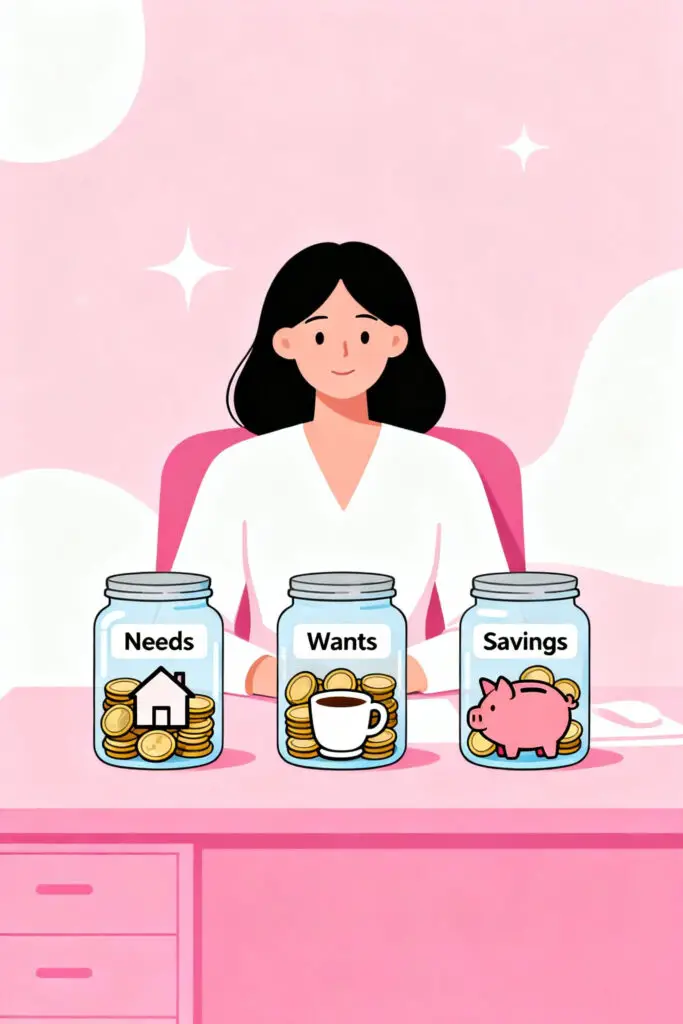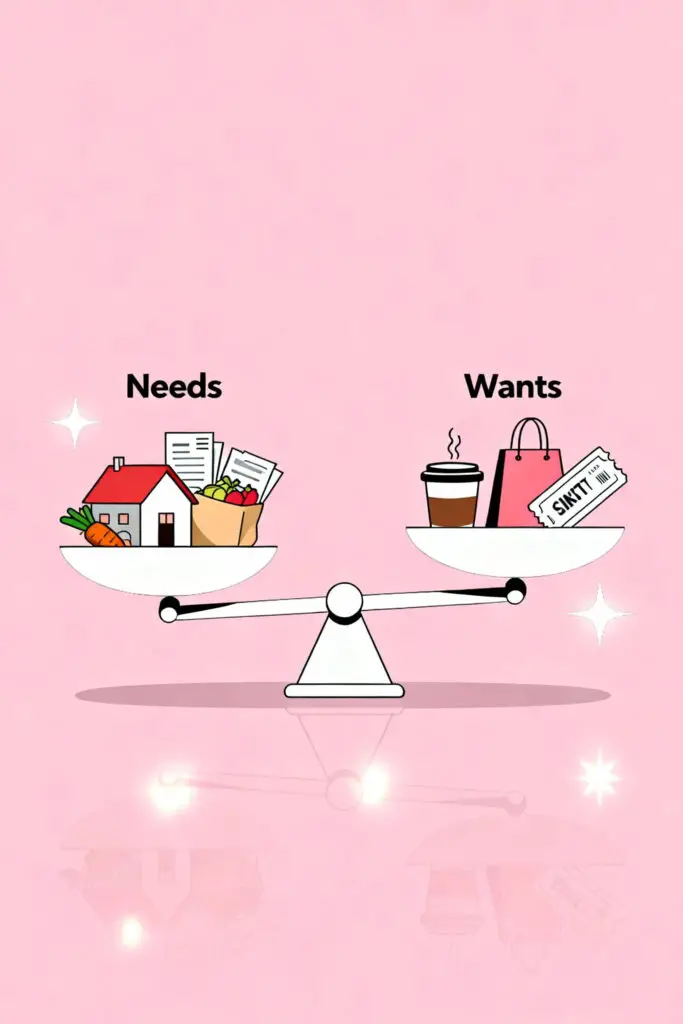When it comes to managing money, budgeting can feel like an overwhelming task with unlimited spending categories, defining their importance, and endless numbers to track. But what if there was a way to make budgeting less complicated and more manageable? The truth is you don’t have to overcomplicate budgeting by creating 50 different spending categories to take control of your finances, you just need 3 simple categories, needs, wants, and savings, to give every dollar a meaning and purpose to serve. This article will help you explore these three simple budget categories in detail, allowing you to a build a simple yet powerful financial plan that works the best for you.
The Simplicity of the 3-Category Budget

Budgeting doesn’t have to feel like an overcomplicated or complex task with multiple spreadsheets to handle or confusing unlimited categories to figure out, it can be a simple yet highly effective way to manage money just by focusing on three main categories, needs, wants, and savings. This approach can help you understand where exactly your money is going without overwhelming you with unnecessary details.
Whether you’re exploring new effective ways to manage money, working on a debt, or trying to save for the future, the simple and straightforward nature of the 3-category budget can help you keep things straight and organized while still working on money management.
Category 1: Needs, The Essentials That Keep You Going
Needs are the necessities and the foundation of your financial life. These are the expenses you can’t avoid because they technically run the course of your life. Whether it’s food, housing, utilities, transportation, or other basic expenses, they fall under the needs category.
The key is to cover and prioritize your needs over both wants and savings, ensuring that you spend on your basic and those essential expenses before you get to your wants and savings. When your needs are taken care of when the paycheck arrives, it provides you with a sense of peace and calm that the essential and most important of expenses are taken care of.
Understanding What Truly Counts as a “Need”
It is easy to make mistakes by considering some of your wants as needs, especially in today’s world where lifestyle upgrades are treated as a necessity. An important step in this method is to truly understand what counts as a need. This can help you stay mindful and more intentional with your spending habits, spending thoughtfully on things that truly count as essential expenses or needs.
For example, having a phone is a need but having an upgraded phone is more of a want. Similarly, groceries are a need but eating out, takeouts, or those coffee runs are about fun and enjoyment rather than necessity. Once you’re honest about what is truly a need for you, you can start managing money in a more effective manner.
Category 2: Wants, The Things That Bring Joy
The next category is of wants that are things that make life enjoyable and add an element of fun and happiness to it. While it feels nice to have wants, they’re not a necessity, aren’t necessary for survival, and should not be prioritized over needs.
However, having your wants addressed can add motivation to the whole budgeting process. Budgeting is not only about restricting yourself or holding back on things you enjoy it’s about finding the right balance between personal spending and mindful spending and when you create a plan that includes your wants as well, you can enjoying spending on your wants without any guilt because you’ve already assigned a category to it, helping you stay motivated and consistent along the process,
Finding Balance Between Needs and Wants

One of the most important steps in budgeting is finding the right balance between needs and wants. If you spend too much on your wants or those nice-to-have items, you may struggle to pay for your needs and savings, similarly, if you spend a lot on your needs, you may find the whole journey restrictive or more like a punishment, leaving no room behind for savings as well, making it crucial to find a balance.
The key is to allow yourself to do the things you enjoy but in limits, for example, instead of cutting coffee off entirely, you can still have it but 3-4 times a week. This way you can still enjoy the things you like without putting your progress or finances at stake.
Category 3: Savings and Future Goals
The next and last category is savings and this is where you prepare for your financial future and save small amounts over time. Savings can cover anything, whether it’s an emergency fund, retirement contribution, investment, or even a big fun holiday you’ve planned out for your family.
This category is more about paying your future self rather than focusing on those short-term pleasures that don’t last long. Even small, consistent savings can grow over time and make a big difference in your financial stability. By setting aside money regularly, you create a safety net that gives you peace of mind and opens doors to bigger opportunities in life.
Why Savings Deserve Priority
Many people, at times, use the leftover money for savings, and that mindset surely leads them to never saving at all. Prioritizing savings ensures that your financial goals are important for you and they are a part of the plan.
Whether it’s building an emergency fund for unexpected events, setting aside money for retirement, or saving up for a long-term dream, every bit adds up and creates a safety net that helps you live with confidence and less stress. Over time, those small and steady amounts can turn into something meaningful, not just financially, but also emotionally, because you know you’re prepared for whatever life may bring.
The Ideal Balance: The 50/30/20 Rule
When it comes to dividing your income among these three categories, the 50/30/20 rule offers one of the simplest and most effective ways to maintain balance. The idea is to allocate 50% of your income to needs, 30% to wants, and 20% to savings. This formula keeps things structured yet flexible enough to fit into different lifestyles and income levels.
It’s not about sticking to these numbers with perfection but about using them as a guideline to find what balance feels right for you. For example, if you live in an area where housing costs take up more than half your income, you might need to adjust your percentages slightly while still keeping savings and wants within reach.
How to Apply the 3 Categories in Real Life
Applying these three categories in your everyday life doesn’t have to feel like a strict or complicated process, it’s more about awareness and intention than about rules. Start by writing down your total income, then divide it into your needs, wants, and savings based on the 50/30/20 guideline or any ratio that feels practical for your situation.
Once you’ve done that, track your expenses for a few weeks to see if you’re staying within those boundaries. You might be surprised to find that some of your “needs” can actually be reduced, or that certain “wants” don’t bring you as much joy as you thought.
Adjusting as Life Change
Your budget, much like your life, isn’t meant to stay the same forever. As your circumstances evolve, whether it’s a job change, a new family member, or a shift in priorities, your budget should evolve with you.
The beauty of the 3-category system is that it’s flexible enough to adjust as life changes. You can easily revisit your spending ratios, move things around, and reshape your priorities depending on what phase of life you’re in. For example, during times when expenses rise, you might need to cut back temporarily on wants, and when your income increases, you can put more toward savings or investments.
The Emotional Side of Budgeting
Many people associate budgeting with sacrifice or restriction, but in reality, it’s about self-care and self-awareness. When you budget mindfully, you’re choosing peace over pressure, confidence over confusion, and purpose over impulse. You start to feel more in control, more grounded, and less anxious about your financial future.
Instead of feeling guilty after spending, you feel assured because you know your choices are intentional and within limits.
How These 3 Categories Build Financial Freedom
When you simplify your budgeting process into these three categories, needs, wants, and savings, you create a structure that’s easy to follow yet powerful enough to change your financial life.
This system builds discipline without rigidity, letting you meet your responsibilities, enjoy your present, and secure your future all at once. Over time, as your savings grow and your spending habits become more mindful, you begin to experience a deeper sense of freedom, not just from debt or financial stress, but from the anxiety that comes with uncertainty.
Conclusion
At the end of the day, budgeting doesn’t have to be a long list of complicated categories or strict calculations that drain your energy and motivation. The 3-category budget simplifies the entire process, turning something that often feels overwhelming into something empowering. By focusing on needs, wants, and savings, you give your money a clear direction while keeping your life balanced and joyful. It’s not about perfection, it’s about progress and consistency. When you learn to manage your money with simplicity and intention, you build not only a stronger financial foundation but also a calmer and more confident mindset that carries you through every stage of life.
